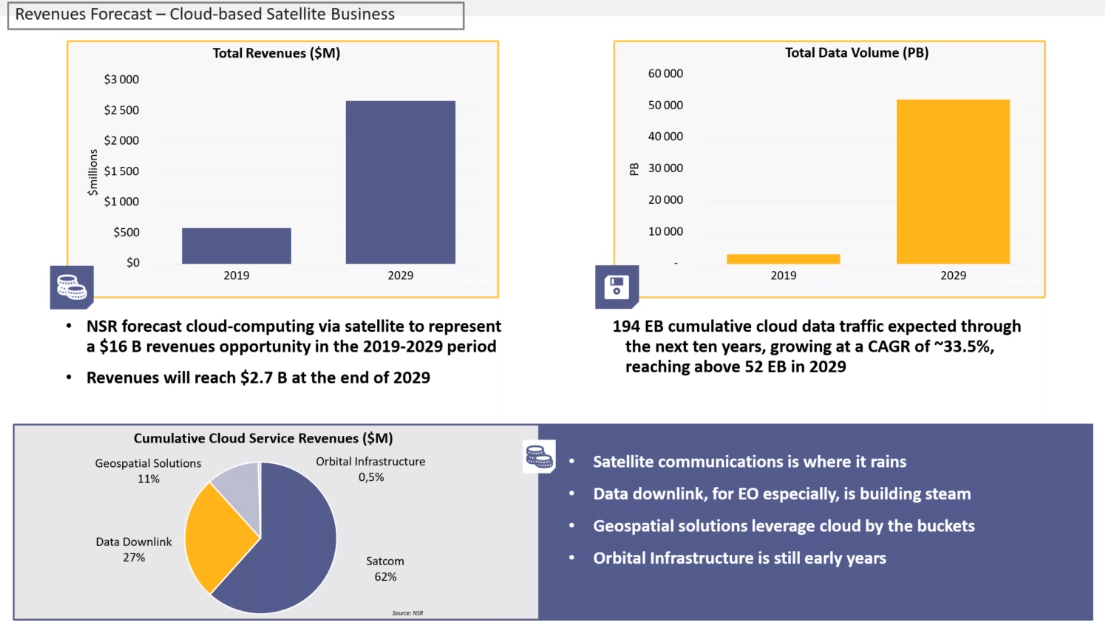
There is no question that the space industry is rapidly growing and transforming, considering that the number of satellites being launched over the next decade is expected to quintuple. As AWS Director of Aerospace and Satellite Maj Gen Clint Crosier said at a recent industry event: “space is growing astronomically – space pun intended.”
This rapid industry growth means that both the space and ground segment need to efficiently process the growing amount of data being collected. The cloud could be an answer for the need to optimize data computing and processing, while being able to connect hardware-based components and software-based components in a more integrated way.
Maj Gen Crosier spoke about the space industry’s relationship with the cloud on a joint AWS and NSR webinar titled “Space and the Cloud,” which is part of a larger webinar series on cloud connectivity. He was joined by NSR Senior Analyst Shivaprakash Muruganandham and NSR Research Director Claude Rousseau, who shared findings from an NSR research report titled Cloud Computing Via Satellite.
Muruganandham defined the cloud as “the act of running workloads within abstracted IT environments, and being able to pool and share these scalable resources across an entire network.”
Delving further into NSR’s report, Muruganandham explained that the cloud is a key driver of a new wave of space and satellite innovation. “Cloud will be a critical component that ensures satellite players remain competitive,” he said. “Cloud is a means to ensure data delivery in big data applications – this is true from satcom to sensing [applications].” It was also noted that the shift to the cloud is linked to the trend of using big data analytics across the industry.
Maj Gen Crosier agreed with this sentiment. “If space companies don’t fully embrace the move to the cloud, they won’t remain competitive for very long. Competitors in other industries are moving now in tidal waves in the space enterprise to the cloud,” he said.
The good news is that cloud-based satellite business revenues are growing – NSR forecasts cloud-computing via satellite to grow to $2.7 billion by the end of 2029, with $16 billion worth of revenue opportunity between 2019 and 2029.
 Cloud-based satellite business visualization from AWS and NSR’s joint webinar “Space and the Cloud.” Photo credit: NSR
Cloud-based satellite business visualization from AWS and NSR’s joint webinar “Space and the Cloud.” Photo credit: NSR
With more of the space industry flocking to the cloud, an audience poll was conducted during the webinar, asking: What are the most important drivers of cloud usage in the satellite market?
The top two results of the poll were integration with customers systems and lower CAPEX, with other choices being security requirements, complete processing capabilities, and value-added services including APIs, Machine Learning (ML), and Artificial Intelligence (AI). Muruganandham later clarified that although the leading driver was lower CAPEX, all the choices were valid answers – he put it more simply, saying “cloud is eating across the entire satellite value chain.”
Diving deeper into an advantage of using the cloud is a reduction of both CAPEX and OPEX. “A satcom operator or service provider can outsource different operational functions to a mature cloud service provider,” Muruganandham explained. “With established SLAs [Service Level Agreements], you get to improve efficiencies and development times. This translates into easing the barrier to market entry, allowing newer players to enter the market – and this is a key factor in driving the NewSpace economy.”
Yet with the advantages seemingly clear, what are the roadblocks in moving toward the cloud?
Crosier identified security as one: “In my 33 years of experience in the space industry, we have been relatively slow to embrace the cloud. There are good reasons for that – security has always been one of the biggest challenges.”
Constellations followed up with Muruganandham, who commented on addressing cloud-related security concerns: “Adoption of cloud-computing is a double-edged sword: while it brings about all these advantages related to lower costs, improved scalability, access to compute/processing infrastructure and enabling newer business opportunities (particularly downstream in satcom and EO) the increased complexity of these networks will make the detection and prevention of security breaches that much more difficult – this is especially true for sensitive GovMil and commercial applications.”
He continued: “That said, leading cloud service providers are also entities that are at the forefront of technology when it comes to cloud-based security, and the SLAs in this business offer end-to-end encryption and related services that will suffice for most commercial applications.”
Even with the challenges that lie ahead, migrating to the cloud is seemingly both a useful tool and a growing revenue opportunity for the space industry.
